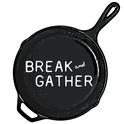Chilling overnight: biscuit dough vs. cookie dough
I've been on a bit of a biscuit quest lately. I'm tweaking my biscuit recipe. I've come across something that seems to be somewhat of a contradiction. Both cookie dough and biscuit dough made with leavening have basically the same ingredients in them (fat, flour, leavening, salt, [sometimes] sugar and eggs and/or dairy).
Why do so many people rest their cookie dough overnight but never biscuit dough? I've heard many even say that the biscuits can lose their leavening by being stored overnight in the fridge.
I recently froze and refrigerated a few rounds of biscuit dough. I found that the frozen ones did rise higher, but the refrigerated ones had a nicer shape. They still rose, just not quite as much. My thinking is that by starting with a colder dough (versus fresh / room temperature dough), the biscuits will hold a better shape and rise nice and evenly.
Any thoughts on this? I'd love some insight.
4 Comments
My question pertains to baking biscuit dough after it has been frozen. How much additional baking time should you allow if you choose to freeze the biscuits before baking?
I've tried chilling unbaked biscuits before baking and have had undesirable results, so will try the freezing method (I work late during the week, so nice to be able to pre-prepare the dough when possible).
Creaming method/standard "chocolate chip" Cookie dough and American Southern Biscuits actually don't have a lot in common, besides their ingredients. the method and the outcome and the ratios are apples and quince to each other; the main difference being eggs and sugar in the former. In a cookie one wants all ingredients to be room temperature, in a biscuit one wants all to be very chilled or frozen.
My experience is that the simpler the dough, meaning the less ingredients, the more it prefers the freezer. Pie/galette/brisée dough, puff pastry, crackers, choux, sucre, sable, etc. This is because the freezer is dry cold, and the fridge is wet cold. In the freezer these doughs literally freeze-frame. They stand at attention until their entry into the oven. Almost everything baked from the freezer will hold its shape better. The freezer does not let it relax into another pose!
Depending on whose biscuits you're baking, (because every state and every county in every state in The South has a different biscuit opinion/method), most biscuits have the best rise right after they've been made. They may not hold their waist in straight, but they get the best lift, and taste the best. This is my opinion. But when I've had to make more than 100 biscuits at the same time, I freeze them.
Lastly, many simple doughs oxidize in the fridge, but not in the freezer. You'd have to ask Harold McGee the food science specifics on this one, but from plain old experience in the kitchen, I can tell you that oxidized dough does not rise or taste as good as dough that is not oxidized. As soon as I see a grey parlor on dough, I know it's spent too long at the wrong temperature. We recently had an issue with our brisée at Bakeri, and the cause was a baker who was leaving it out at room temperature for too long before sheeting/rolling it. She thinks I'm mean, but now the dough is back to being its flaky self.
ps. Home bakers and restaurant pastry chefs are always afraid to keep their batters and doughs for longer than a day or two. But bakers in bakeries will tell you that's nonsense. I've baked cake batter that's six days old to little to no ill or different effect! Leavening does not die if you look at it too long. But it can lose it's umph, especially if an acidulated liquid is near (buttermilk, yogurt, molasses etc.)
I hope all this helps. Making biscuits is so much fun, and deeply satisfying! I hope you're trying new and delicious flours, fats and salts too!
Wow, great reply. Killer notes here. Yes, we are definitely exploring various flavors all the time in our biscuits, from lard and bacon fat to Anson Mills heirloom grains. I need to try playing with salts. I've also recently cut some of the buttermilk with cream and egg, per an article I found on Serious Eats. I think I like it. The cream seemed to tenderize the crumb a bit more and the egg seems to add extra rise and color to the biscuit.
You are so right in how the biscuit is so very simple, yet so complex.
I see what you're saying with methods varying so much between cookie and biscuit. I wasn't really looking at it that way, but it makes sense. And, I had a feeling the acid reacting with the leavening certainly affects things.
I definitely get the best rise when the dough is fresh. No problem there. The thing I get frustrated with is when many of them lean over. I'm cutting them pretty small in diameter. About 2". I have a feeling the key is just the magic touch of being gentle with the dough. I may even consider patting/rolling it out a bit thinner so they don't rise quite so high, because right now they're rising so tall, the height might be causing them to lean.
I feel like as I overthink these biscuits, the more of a challenge they become. 2 years ago, biscuits came out pretty darn good almost always... it's when I started to think that "this" or "that" could improve them.

